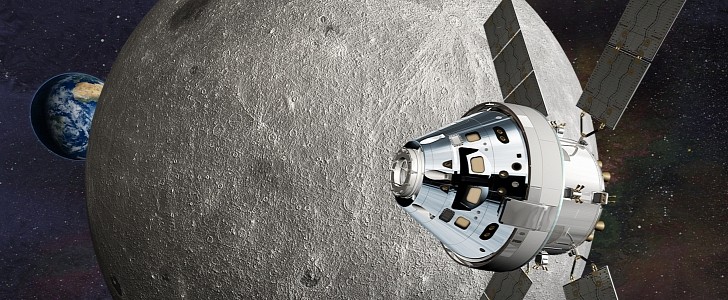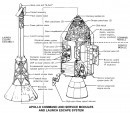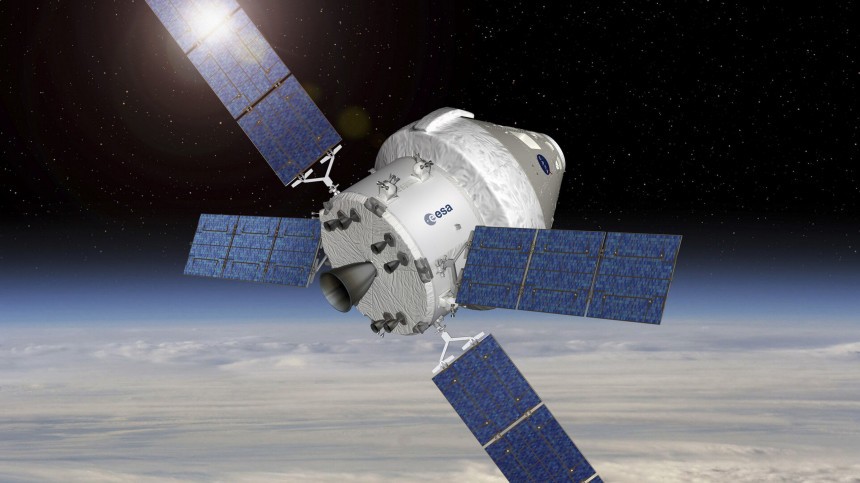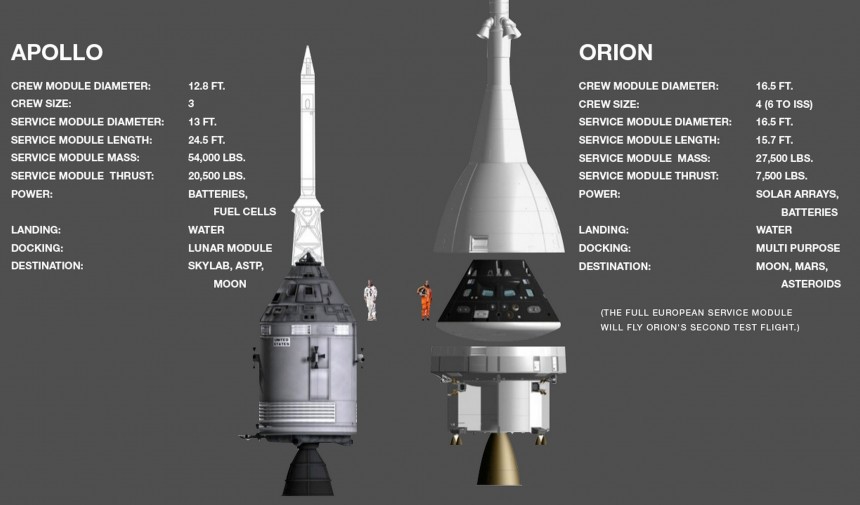The Lockheed Martin Orion is the latest arrival of a human-rated spacecraft slated to take humans beyond the bounds of Low Earth Orbit and close to the surface of another heavenly body. But for all its grace, sophistication, and dedicated design team, there are undoubtedly public misconceptions surrounding the ship.
Why does it look so much like the Apollo Command Module? Why are we still flying capsule-shaped spacecraft fifty years after Apollo? How much better is Orion's computing power compared to what NASA was flying five decades ago? Well, we found the right people to help us answer all these questions.
Say hello to Jacquline Acuna, Assembly, Test, Launch, and Operations (ATLO) integration lead for Lockheed Martin's Orion Spacecraft, and Gary Napier, spokesperson for Lockheed Martin. In all the chaos and pandemonium of the few days before Artemis I launches this Monday, Acuna and Napier sat down with autoevolution to answer some questions based on some of these curiosities. First and foremost, why does Orion look so much like an Apollo Command Module? Especially after the last manned American spacecraft was a reusable space plane.
"First of all, the capsule is, in fact, the right shape. It's all about re-entering the atmosphere at a high velocity of over 25,000 miles per hour," explained Napier. "The laws of physics never changed in the last 50 years. What's changed is the technological capability. The Apollo engineers got it right the first time, so that's why the Orion looks the way it does. All the while, It's about 30 percent larger in interior volume than during Apollo."
But this doesn't mean there's nothing in common between Orion and the Apollo Command Module. The two use heat shields made of a near identical compound known as AVCOAT, a special epoxy novolac resin arranged in a honeycomb pattern that deflects as much ionizing frictional heat away from the spacecraft as possible. "If it's material science, meaning if it's worked at those high speeds before, let's do it again. But we're doing it in a different way to make it much more efficient from a cost and a timing perspective," Napier explained.
Such a design language might seem strange if you've seen the now defunct Space Shuttle travel to places and do things on TV and in films it could never achieve in real life. But as Napier quickly points out, it's important to remember that For all Mankind, Deep Impact, and Armageddon are all works of fiction. "The Space Shuttle could not travel to the Moon, period. It's just not reality. Sending capsules to the Moon and back is the right shape for an extremely high-speed re-entry like we're planning with Artemis."
It's easy to draw parallels between Orion and the Apollo Command Module. Still, with these bits of information in mind, it should be evident why comparing the two is "Like comparing a Ford Model T to a Ferrari." As Napier so eloquently puts it. Orion was a spacecraft designed not with pencils, paper, and slide rules but with AutoCAD technology, microprocessors, and an abundance of digital software that Apollo engineers only wished they had access to.
"Orion is assembled with multiple 3D printed components that weren't possible to build even a short time ago, that will be a vital component of reducing workloads and expediting the development process to help rockets launch into space faster," said Acuna. So in a sense, Orion is indeed using many of the same operating principles as Apollo but using technology that makes Apollo look primitive by comparison.
"It's important to remember that Orion is a fully autonomous-capable spacecraft." Explained Napier, assuring that Lockheed-Martin's flagship spacecraft can handle itself just fine without help from mission control. "If you tell it exactly what it needs to do, it can execute those orders all the way to splashdown. Just like our planetary probes out at Mars, Jupiter, and what have you. You can't say the same about Apollo. Keep in mind, Orion is capable of going to Mars."
Orion's 5x redundant flight computer system with four running in constant parallel is a major factor in why this is the case. All the better when you remember Apollo's guidance computer's power was measured in letters, not bytes, on account of being so puny. By Napier's own account, Orion is 200,000 times more powerful in its computing performance than Apollo. Not that this should shock you, as your smartphone could give Apollo a thrashing.
All in all, Gary Napier and Jacquline Acuna explain wonderfully just how Orion is far more than Apollo on steroids. If all goes according to plans, it'll be even better at its job than the spacecraft of five decades ago. After so much time without a moon program, that's a welcome change if there ever was one. To some, it's the realization of a lifelong dream that once seemed impossible. We can only say that with time, pessimism can turn into optimism in the blink of an eye.
In the end, Jacquline ends the interview with a touching quote about how humbled she feels to work as a small cog in a vast machine that spans continents, cultures, and people from all walks of life. "It makes me humble because so many people have donated so much time and effort on this rocket, the crew module, the whole program, and it's so nice to be a part of something bigger."
Check back soon for more coverage live from the Kennedy Space Center for the launch of Artemis I right here on autoevolution.
Say hello to Jacquline Acuna, Assembly, Test, Launch, and Operations (ATLO) integration lead for Lockheed Martin's Orion Spacecraft, and Gary Napier, spokesperson for Lockheed Martin. In all the chaos and pandemonium of the few days before Artemis I launches this Monday, Acuna and Napier sat down with autoevolution to answer some questions based on some of these curiosities. First and foremost, why does Orion look so much like an Apollo Command Module? Especially after the last manned American spacecraft was a reusable space plane.
"First of all, the capsule is, in fact, the right shape. It's all about re-entering the atmosphere at a high velocity of over 25,000 miles per hour," explained Napier. "The laws of physics never changed in the last 50 years. What's changed is the technological capability. The Apollo engineers got it right the first time, so that's why the Orion looks the way it does. All the while, It's about 30 percent larger in interior volume than during Apollo."
Such a design language might seem strange if you've seen the now defunct Space Shuttle travel to places and do things on TV and in films it could never achieve in real life. But as Napier quickly points out, it's important to remember that For all Mankind, Deep Impact, and Armageddon are all works of fiction. "The Space Shuttle could not travel to the Moon, period. It's just not reality. Sending capsules to the Moon and back is the right shape for an extremely high-speed re-entry like we're planning with Artemis."
It's easy to draw parallels between Orion and the Apollo Command Module. Still, with these bits of information in mind, it should be evident why comparing the two is "Like comparing a Ford Model T to a Ferrari." As Napier so eloquently puts it. Orion was a spacecraft designed not with pencils, paper, and slide rules but with AutoCAD technology, microprocessors, and an abundance of digital software that Apollo engineers only wished they had access to.
"Orion is assembled with multiple 3D printed components that weren't possible to build even a short time ago, that will be a vital component of reducing workloads and expediting the development process to help rockets launch into space faster," said Acuna. So in a sense, Orion is indeed using many of the same operating principles as Apollo but using technology that makes Apollo look primitive by comparison.
Orion's 5x redundant flight computer system with four running in constant parallel is a major factor in why this is the case. All the better when you remember Apollo's guidance computer's power was measured in letters, not bytes, on account of being so puny. By Napier's own account, Orion is 200,000 times more powerful in its computing performance than Apollo. Not that this should shock you, as your smartphone could give Apollo a thrashing.
All in all, Gary Napier and Jacquline Acuna explain wonderfully just how Orion is far more than Apollo on steroids. If all goes according to plans, it'll be even better at its job than the spacecraft of five decades ago. After so much time without a moon program, that's a welcome change if there ever was one. To some, it's the realization of a lifelong dream that once seemed impossible. We can only say that with time, pessimism can turn into optimism in the blink of an eye.
In the end, Jacquline ends the interview with a touching quote about how humbled she feels to work as a small cog in a vast machine that spans continents, cultures, and people from all walks of life. "It makes me humble because so many people have donated so much time and effort on this rocket, the crew module, the whole program, and it's so nice to be a part of something bigger."
Check back soon for more coverage live from the Kennedy Space Center for the launch of Artemis I right here on autoevolution.











